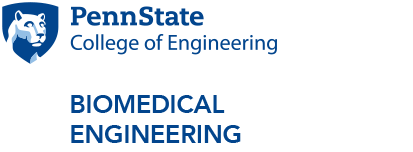
A synthetic tissue releases therapeutic proteins (maroon/yellow) once triggered by metabolites (sandy brown). The metabolites contact with the double-stranded DNA (red/blue) to release the red triggering DNA. The triggering DNA activates the aptamer(cyan)-protein complex to release the protein. Image: Xin Zou/Jinping Lai/Penn State
Mimicking biological process, hydrogel signals and releases proteins
Yong Wang works with researchers and graduate students toward a controlled drug delivery solution
10/26/2017
UNIVERSITY PARK, Pa. — An artificial system using a DNA-laced hydrogel can receive a chemical signal and release the appropriate protein, according to Penn State researchers. Further stimulation by the chemical signal continues to trigger a response.
A hydrogel is a network of polymer chains that attract water and can be used to simulate biological tissue.
Many systems in cells and in the human body are set up with a signal and response pathway. One of the best known is that of glucose, a small sugar that triggers the release of insulin.
“We’ve only done this recently in a petri dish,” said Yong Wang, professor of biomedical engineering. “We did tests using smooth muscle cells, but we would of course like to do this in a living animal.”
The researchers report in the November issue of Chemical Science, “With rational design, this biomimetic hydrogel system would constitute a general platform of controlling the output of signaling proteins for versatile potential applications such as drug delivery, cell regulation, molecular sensing and regenerative medicine.”
The hydrogel, made of polyethylene glycol, is infused with two different types of DNA. One is an aptamer — a short strand of DNA that attaches to the chemical the researchers want to release into the cell. In the case of glucose and insulin, the aptamer would bind with insulin the "drug" the researchers want to release. The other type is a double-stranded helical molecule of DNA chosen to react with the metabolite signal — glucose — and initiate the chemical release.
When the signaling molecule reaches a double strand of DNA, the DNA separates into two strands. One strand binds with the molecule and the other moves toward the aptamer and forces it to release the protein bound to it. The protein can then move through the cells to its normal binding site and perform its normal actions.
“This was not a simple process to create,” said Wang. “One graduate student worked on it for three years before giving up. In total, it took four to five years to get this far.”
The researchers used adenosine as the signaling chemical and platelet-derived growth factor as the signaling protein to be released. The system can repeat the sequence, releasing signaling proteins until there are no more to release.
“We don’t yet know how to easily replenish the proteins,” said Wang.
The researchers tested the adenosine-PDGF-BB hydrogel system and found that without a signal chemical, the amount of signaling protein released by the hydrogel was very small. When the signal chemical — adenosine — was applied, the hydrogel released about 28 percent of the target signaling protein — PDGF-BB. Other chemicals similar to adenosine, like guanosine and uridine did not cause the release of PDGF-BB from the hydrogel.
“Eventually we would like to use this system for controlled drug delivery and other biological actions,” said Wang.
Others at Penn State working on this project are Jinping Lai, research associate; Shihui Li, recent doctoral graduate; Xuechen Shi, recent master's graduate; and James Coyne and Nan Zhao, doctoral candidates — all in the Department of Biomedical Engineering; and Fengping Dong, doctoral candidate; and Yingwei Mao, associate professor, both in the Department of Biology.
The National Science Foundation and the National Institutes of Health supported this work.



